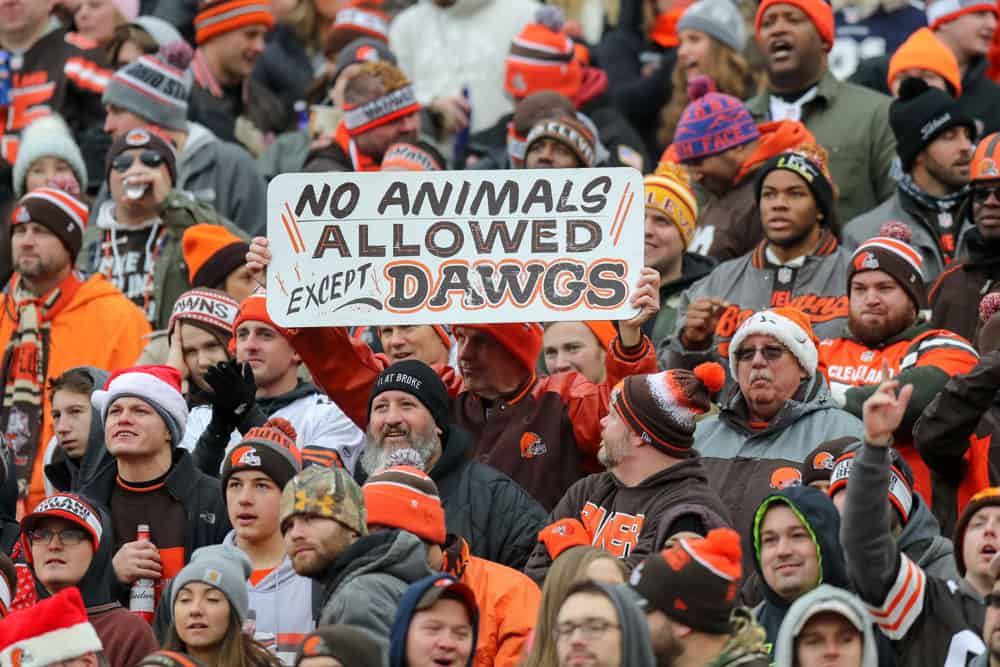When the AFL and NFL merged in 1970, the new NFL split the 26 teams into two conferences.
Many natural intrastate rivals, like the Jets and Giants or 49ers and Raiders, were placed in opposite conferences.
But the Cincinnati Bengals and Cleveland Browns landed in the AFC Central, assuring two contests per year.
The Battle Of Ohio
It was a revenge match between two owners that hated each other.
Paul Brown, the founder of the team that bears his name, was pushed out of his job in 1963 by Art Modell.
When Brown founded the Cincinnati Bengals in the AFL, he might have envisioned a future on-field encounter.
It didn´t happen until the leagues merged in 1970 when they were set up to do battle twice a year.
But they actually met three times in that first season.
Cincinnati took a preseason game from the Browns to the dismay of their fans.
Cleveland saved face by winning the first regular-season matchup, 30-27 at home.
But Paul Brown and the Bengals got the last laugh with a 14-10 victory that clinched the division title.
Neither team had much success in the 1970s, tamping down the rivalry just a bit.
But then came the 1980s, and Bernie Kosar, Boomer Esiason, and five years of intrastate division battles.
Ohio Captures 6 Straight Division Titles!
Boomer Esiason entered the league in 1984 with a chip on his shoulder.
He was irate he fell to the second round, even though he was the first quarterback chosen.
Bernie Kosar created his own controversy by insisting he plays for his hometown Cleveland Browns.
After lawsuits, rule changes, and much anger, Kosar arrived via the 1985 supplemental draft.
Kosar was pushed into a starting role for the injured Gary Danielson during his rookie season.
He was asked to manage a run-oriented offense and struggled to a 4-6 record.
Meanwhile, Esiason was 7-7 for Cincinnati and the teams were neck-and-neck with Pittsburgh.
But a 24-6 victory against the Bengals helped give the division to the 8-8 Browns.
Cincinnati settled for second at 7-9.
Another late-season win over the Bengals gave Cleveland a second straight title in 1986.
The 34-3 rout on the road was part of a 12-4 campaign and left the Bengals in second place at 10-6.
Cincinnati faltered during the strike-shortened 1987 season, finishing with a last-place 4-11 record.
Meanwhile, Kosar had one of his finest seasons, leading the Browns to a third title with a 10-5 finish.
Esiason bounced back with an All-Pro season, leading the Bengals to a 12-4 record and the division title.
In fact, his career highs in touchdowns and yardage led Cincy to their second Super Bowl appearance.
Cincinnati swept the 1989 Battles of Ohio, but the Browns got the last laugh.
The teams finished within a game and a half of each other.
But the Bengals´ 8-8 record left them in 4th place while the Browns took another title at 9-6-1.
Esiason and the Bengals scored some revenge with a 1990 sweep on their way to the 1990 title.
They needed both of those wins as division victories broke a three-way tie with Pittsburgh and Houston.
Glory Years, Without the Glory
Few would argue the Battle for Ohio was never more exciting than the late 80s.
Browns and Bengals fans lived large behind their quarterbacks´ success for six years.
Kosar set a record for consecutive games (3) with three or more touchdown passes.
His 489 passing yards against the Jets in 1986 was the most in a playoff game to that point.
In 1990, he started the season completing 286 passes before his first interception.
Kosar was named to the Pro Bowl in 1987.
Meanwhile, Boomer Esiason racked up three Pro Bowl appearances and his lone All-Pro selection.
He tacked on an NFL MVP award in 1988.
By today´s standards, their statistics don´t stand out.
But there is one other thing that diminished their best years in the NFL.
Cincinnati´s heartbreaking loss in the 1988 Super Bowl was the closest either came to a Lombardi trophy.
Esiason and the Bengals went 3-2 in the postseason, losing the division playoff in 1990.
Cleveland had more playoff seasons, but they could never get past the Denver (bleeping) Broncos.
Three times, the Broncos took the AFC title at the expense of the Browns.
Overall, Kosar´s teams were 3-5 over five playoff seasons.
Then Came the Dark Years
Cleveland Browns like to call Art Modell the worst owner in history.
His failed business enterprises and moving the original team to Baltimore earned him the title.
But there is no love lost for the sons of Paul Brown in Cincinnati.
Their penny-pinching ways dragged the Bengals to the depths of the NFL in the 1990s.
Cincinnati suffered through the decade without a winning season.
Then, Marvin Lewis showed them how to win again, but created a special hell for the Bengals´fans.
Lewis won more games than he lost, but he never won a playoff game.
In fact, Cincinnati managed to lose 7 wild card games during Lewis´ tenure.
Meanwhile, Cleveland fans had their own problems.
Bill Belichick managed one playoff season in 1994 for the Browns.
Since then, the team has lost a 2002 wild card game and own one winning season (2007) since.
The only coach with a winning record since 2007 was interim coach Gregg Williams (5-3) in 2018.
That led to all kinds of excitement before the Browns stumbled the following season.
Can the 2020’s Bring Back the Glory?
NEXT: Predicting The Browns' 3 Most Valuable Players On Defense In 2020